Project Report: Vodafone's Equality and Diversity Initiatives (Unit 6)
VerifiedAdded on 2021/02/20
|18
|3787
|23
Report
AI Summary
This project report examines Vodafone's initiatives in promoting equality and diversity within its workforce. The report begins with an introduction to the concepts of equality and diversity and their importance in the workplace. It then outlines the project's aims and objectives, followed by a detailed project management plan covering cost, scope, time, quality, communication, and risk. A work breakdown structure and Gantt chart are presented to illustrate the project's timeline and activities. The report then delves into the research methodologies employed, including qualitative and quantitative approaches, and data collection methods such as questionnaires. The findings from the research are analyzed using appropriate tools and techniques, with interpretations of the data. The report concludes with recommendations for Vodafone based on the research findings and a reflection on the project's outcomes.
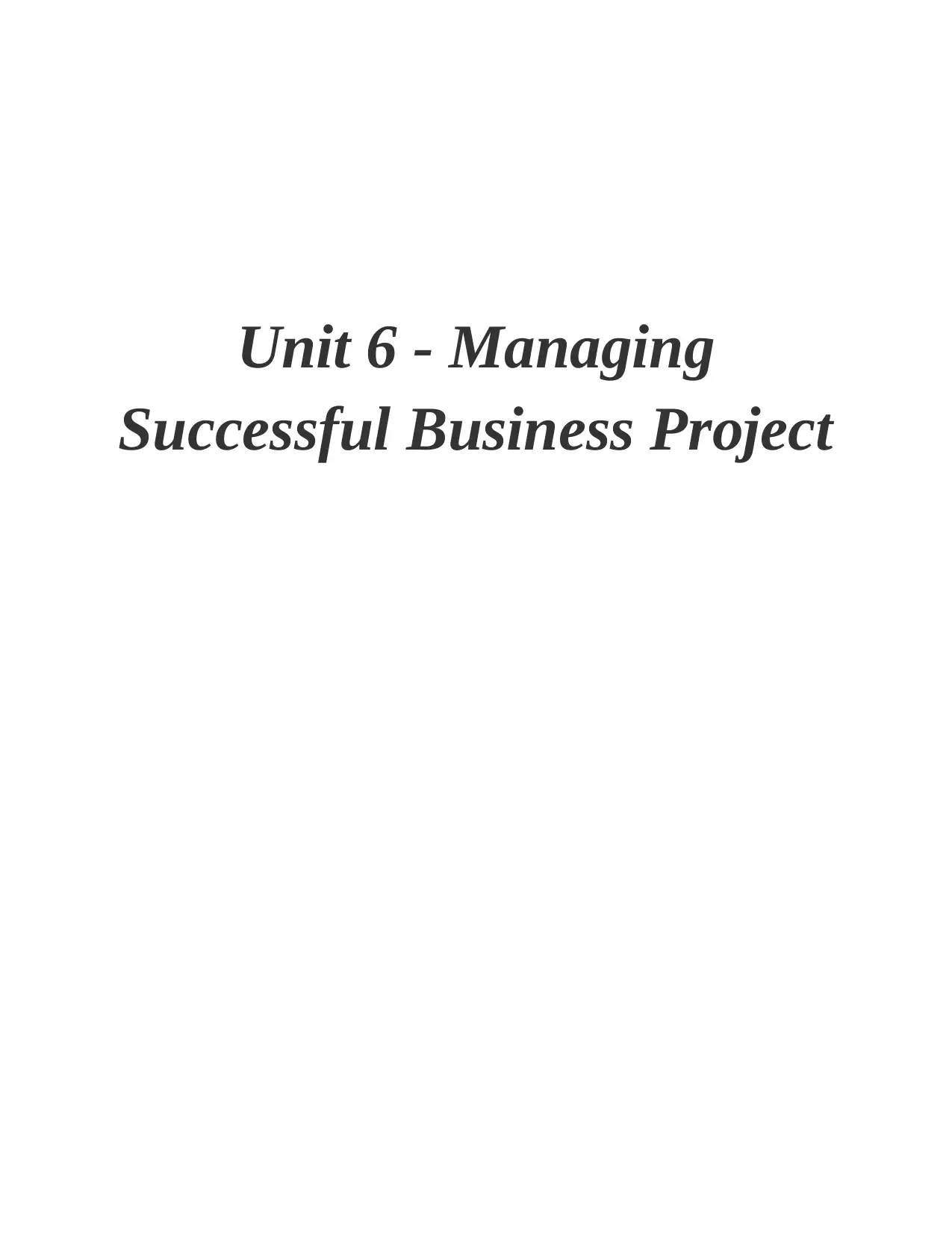
Unit 6 - Managing
Successful Business Project
Successful Business Project
Paraphrase This Document
Need a fresh take? Get an instant paraphrase of this document with our AI Paraphraser
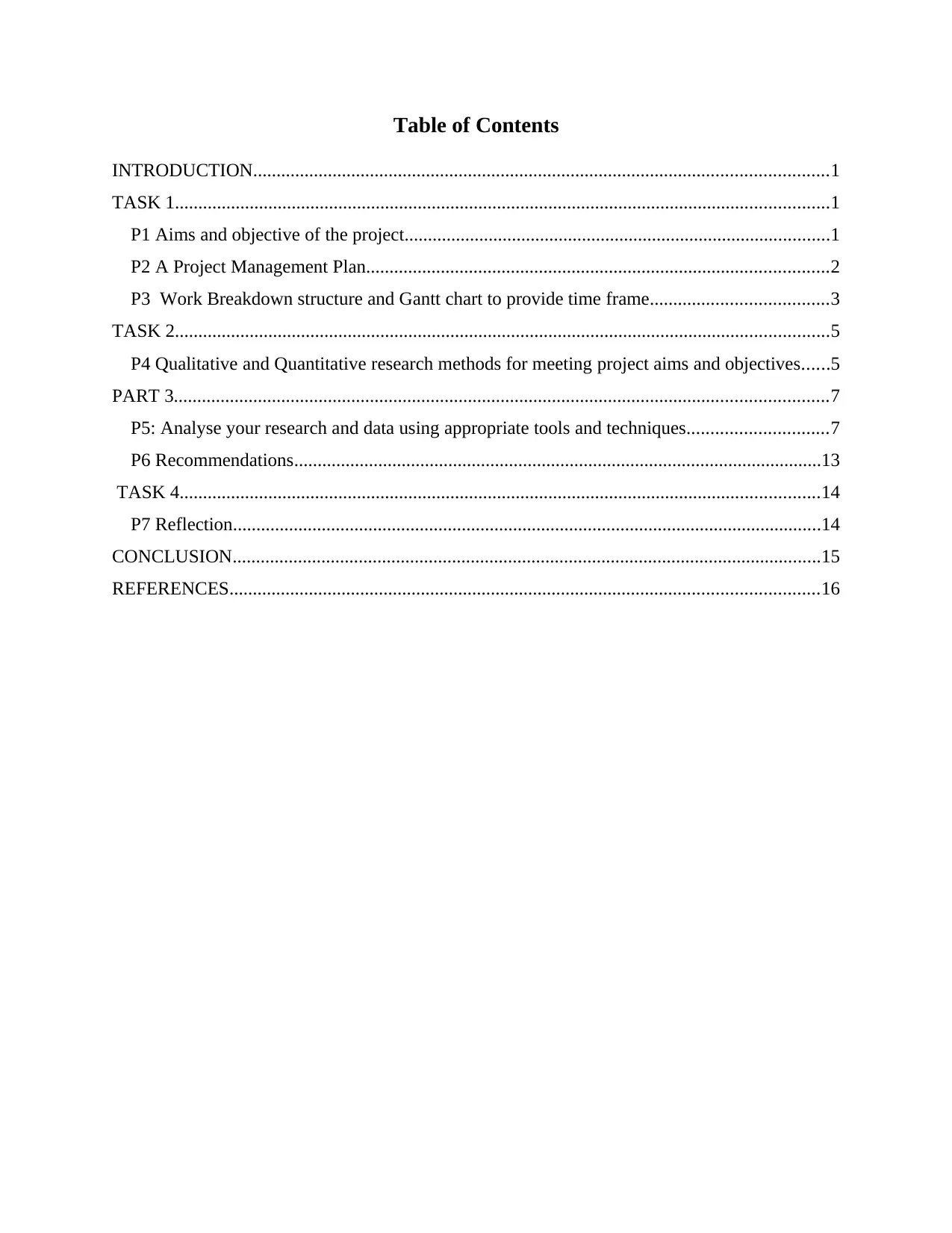
Table of Contents
INTRODUCTION...........................................................................................................................1
TASK 1............................................................................................................................................1
P1 Aims and objective of the project...........................................................................................1
P2 A Project Management Plan...................................................................................................2
P3 Work Breakdown structure and Gantt chart to provide time frame......................................3
TASK 2............................................................................................................................................5
P4 Qualitative and Quantitative research methods for meeting project aims and objectives......5
PART 3............................................................................................................................................7
P5: Analyse your research and data using appropriate tools and techniques..............................7
P6 Recommendations.................................................................................................................13
TASK 4.........................................................................................................................................14
P7 Reflection..............................................................................................................................14
CONCLUSION..............................................................................................................................15
REFERENCES..............................................................................................................................16
INTRODUCTION...........................................................................................................................1
TASK 1............................................................................................................................................1
P1 Aims and objective of the project...........................................................................................1
P2 A Project Management Plan...................................................................................................2
P3 Work Breakdown structure and Gantt chart to provide time frame......................................3
TASK 2............................................................................................................................................5
P4 Qualitative and Quantitative research methods for meeting project aims and objectives......5
PART 3............................................................................................................................................7
P5: Analyse your research and data using appropriate tools and techniques..............................7
P6 Recommendations.................................................................................................................13
TASK 4.........................................................................................................................................14
P7 Reflection..............................................................................................................................14
CONCLUSION..............................................................................................................................15
REFERENCES..............................................................................................................................16
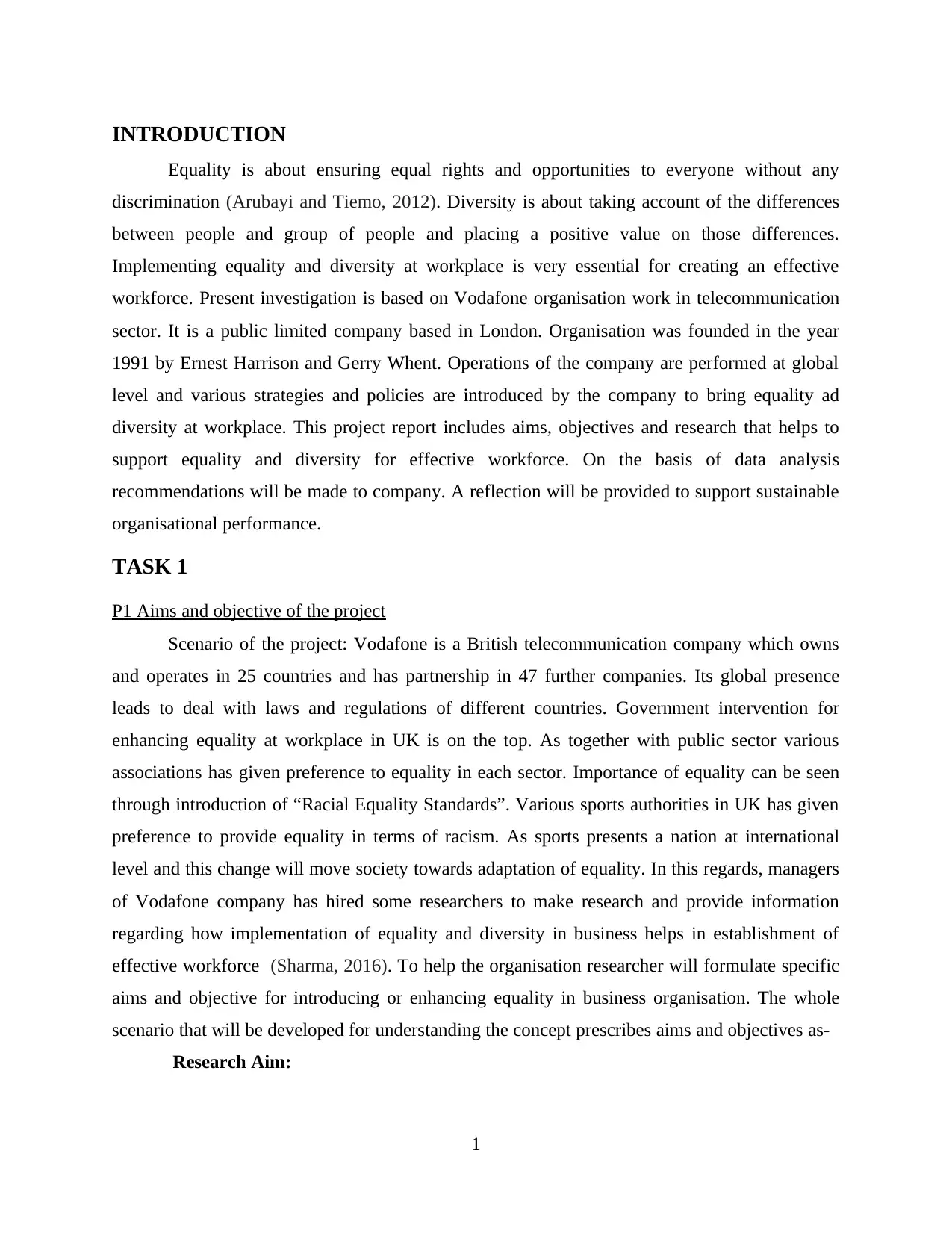
INTRODUCTION
Equality is about ensuring equal rights and opportunities to everyone without any
discrimination (Arubayi and Tiemo, 2012). Diversity is about taking account of the differences
between people and group of people and placing a positive value on those differences.
Implementing equality and diversity at workplace is very essential for creating an effective
workforce. Present investigation is based on Vodafone organisation work in telecommunication
sector. It is a public limited company based in London. Organisation was founded in the year
1991 by Ernest Harrison and Gerry Whent. Operations of the company are performed at global
level and various strategies and policies are introduced by the company to bring equality ad
diversity at workplace. This project report includes aims, objectives and research that helps to
support equality and diversity for effective workforce. On the basis of data analysis
recommendations will be made to company. A reflection will be provided to support sustainable
organisational performance.
TASK 1
P1 Aims and objective of the project
Scenario of the project: Vodafone is a British telecommunication company which owns
and operates in 25 countries and has partnership in 47 further companies. Its global presence
leads to deal with laws and regulations of different countries. Government intervention for
enhancing equality at workplace in UK is on the top. As together with public sector various
associations has given preference to equality in each sector. Importance of equality can be seen
through introduction of “Racial Equality Standards”. Various sports authorities in UK has given
preference to provide equality in terms of racism. As sports presents a nation at international
level and this change will move society towards adaptation of equality. In this regards, managers
of Vodafone company has hired some researchers to make research and provide information
regarding how implementation of equality and diversity in business helps in establishment of
effective workforce (Sharma, 2016). To help the organisation researcher will formulate specific
aims and objective for introducing or enhancing equality in business organisation. The whole
scenario that will be developed for understanding the concept prescribes aims and objectives as-
Research Aim:
1
Equality is about ensuring equal rights and opportunities to everyone without any
discrimination (Arubayi and Tiemo, 2012). Diversity is about taking account of the differences
between people and group of people and placing a positive value on those differences.
Implementing equality and diversity at workplace is very essential for creating an effective
workforce. Present investigation is based on Vodafone organisation work in telecommunication
sector. It is a public limited company based in London. Organisation was founded in the year
1991 by Ernest Harrison and Gerry Whent. Operations of the company are performed at global
level and various strategies and policies are introduced by the company to bring equality ad
diversity at workplace. This project report includes aims, objectives and research that helps to
support equality and diversity for effective workforce. On the basis of data analysis
recommendations will be made to company. A reflection will be provided to support sustainable
organisational performance.
TASK 1
P1 Aims and objective of the project
Scenario of the project: Vodafone is a British telecommunication company which owns
and operates in 25 countries and has partnership in 47 further companies. Its global presence
leads to deal with laws and regulations of different countries. Government intervention for
enhancing equality at workplace in UK is on the top. As together with public sector various
associations has given preference to equality in each sector. Importance of equality can be seen
through introduction of “Racial Equality Standards”. Various sports authorities in UK has given
preference to provide equality in terms of racism. As sports presents a nation at international
level and this change will move society towards adaptation of equality. In this regards, managers
of Vodafone company has hired some researchers to make research and provide information
regarding how implementation of equality and diversity in business helps in establishment of
effective workforce (Sharma, 2016). To help the organisation researcher will formulate specific
aims and objective for introducing or enhancing equality in business organisation. The whole
scenario that will be developed for understanding the concept prescribes aims and objectives as-
Research Aim:
1
⊘ This is a preview!⊘
Do you want full access?
Subscribe today to unlock all pages.

Trusted by 1+ million students worldwide
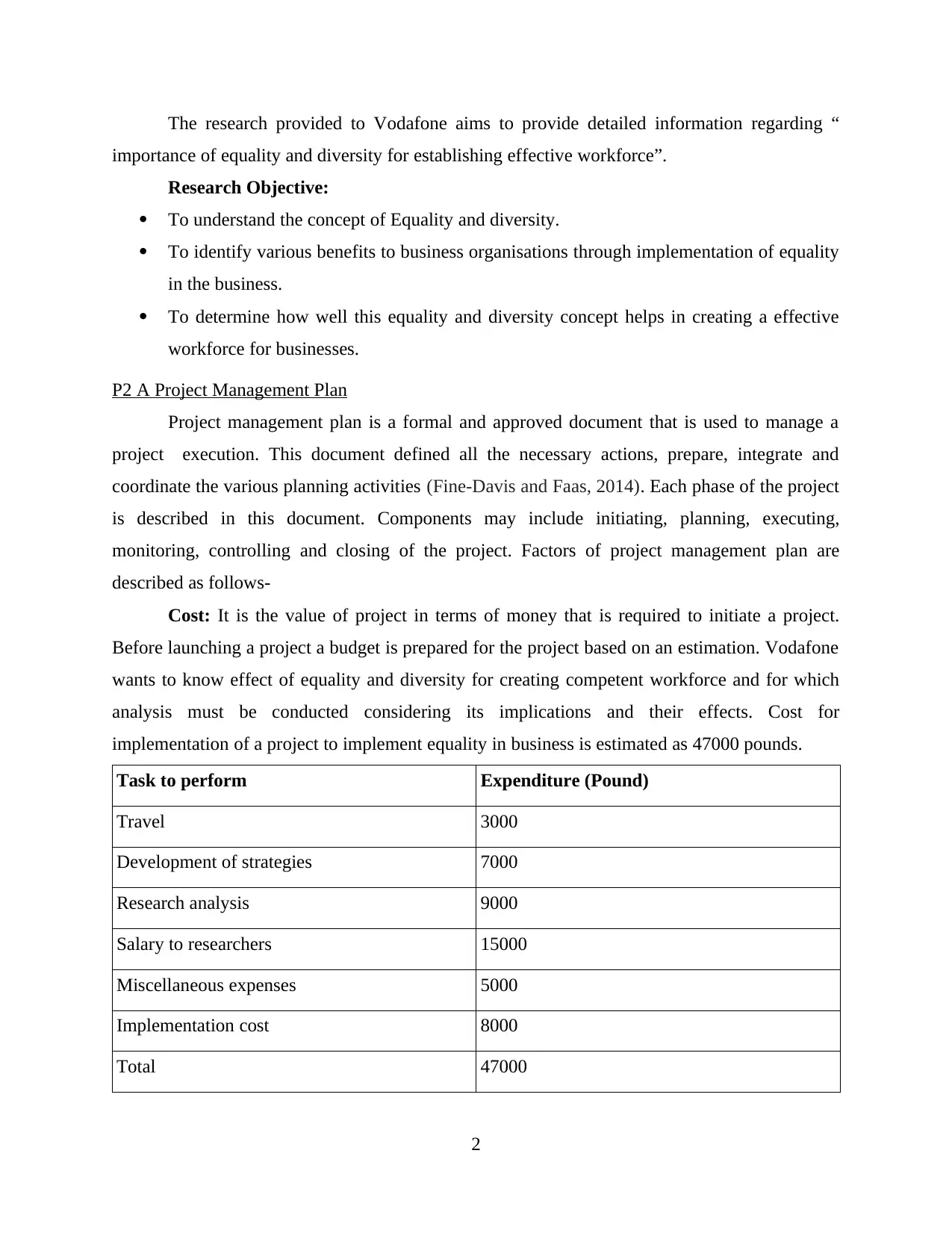
The research provided to Vodafone aims to provide detailed information regarding “
importance of equality and diversity for establishing effective workforce”.
Research Objective:
To understand the concept of Equality and diversity.
To identify various benefits to business organisations through implementation of equality
in the business.
To determine how well this equality and diversity concept helps in creating a effective
workforce for businesses.
P2 A Project Management Plan
Project management plan is a formal and approved document that is used to manage a
project execution. This document defined all the necessary actions, prepare, integrate and
coordinate the various planning activities (Fine-Davis and Faas, 2014). Each phase of the project
is described in this document. Components may include initiating, planning, executing,
monitoring, controlling and closing of the project. Factors of project management plan are
described as follows-
Cost: It is the value of project in terms of money that is required to initiate a project.
Before launching a project a budget is prepared for the project based on an estimation. Vodafone
wants to know effect of equality and diversity for creating competent workforce and for which
analysis must be conducted considering its implications and their effects. Cost for
implementation of a project to implement equality in business is estimated as 47000 pounds.
Task to perform Expenditure (Pound)
Travel 3000
Development of strategies 7000
Research analysis 9000
Salary to researchers 15000
Miscellaneous expenses 5000
Implementation cost 8000
Total 47000
2
importance of equality and diversity for establishing effective workforce”.
Research Objective:
To understand the concept of Equality and diversity.
To identify various benefits to business organisations through implementation of equality
in the business.
To determine how well this equality and diversity concept helps in creating a effective
workforce for businesses.
P2 A Project Management Plan
Project management plan is a formal and approved document that is used to manage a
project execution. This document defined all the necessary actions, prepare, integrate and
coordinate the various planning activities (Fine-Davis and Faas, 2014). Each phase of the project
is described in this document. Components may include initiating, planning, executing,
monitoring, controlling and closing of the project. Factors of project management plan are
described as follows-
Cost: It is the value of project in terms of money that is required to initiate a project.
Before launching a project a budget is prepared for the project based on an estimation. Vodafone
wants to know effect of equality and diversity for creating competent workforce and for which
analysis must be conducted considering its implications and their effects. Cost for
implementation of a project to implement equality in business is estimated as 47000 pounds.
Task to perform Expenditure (Pound)
Travel 3000
Development of strategies 7000
Research analysis 9000
Salary to researchers 15000
Miscellaneous expenses 5000
Implementation cost 8000
Total 47000
2
Paraphrase This Document
Need a fresh take? Get an instant paraphrase of this document with our AI Paraphraser
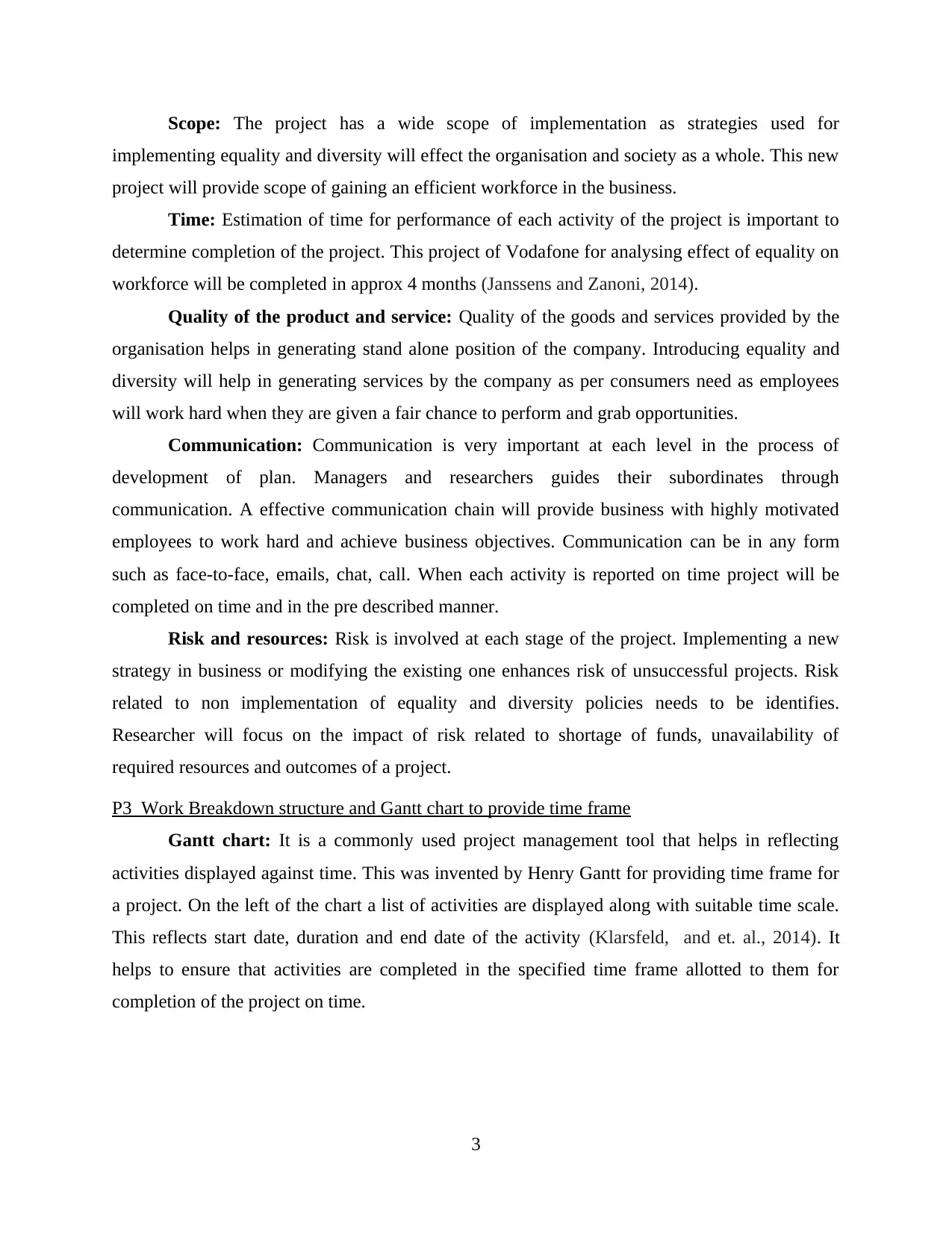
Scope: The project has a wide scope of implementation as strategies used for
implementing equality and diversity will effect the organisation and society as a whole. This new
project will provide scope of gaining an efficient workforce in the business.
Time: Estimation of time for performance of each activity of the project is important to
determine completion of the project. This project of Vodafone for analysing effect of equality on
workforce will be completed in approx 4 months (Janssens and Zanoni, 2014).
Quality of the product and service: Quality of the goods and services provided by the
organisation helps in generating stand alone position of the company. Introducing equality and
diversity will help in generating services by the company as per consumers need as employees
will work hard when they are given a fair chance to perform and grab opportunities.
Communication: Communication is very important at each level in the process of
development of plan. Managers and researchers guides their subordinates through
communication. A effective communication chain will provide business with highly motivated
employees to work hard and achieve business objectives. Communication can be in any form
such as face-to-face, emails, chat, call. When each activity is reported on time project will be
completed on time and in the pre described manner.
Risk and resources: Risk is involved at each stage of the project. Implementing a new
strategy in business or modifying the existing one enhances risk of unsuccessful projects. Risk
related to non implementation of equality and diversity policies needs to be identifies.
Researcher will focus on the impact of risk related to shortage of funds, unavailability of
required resources and outcomes of a project.
P3 Work Breakdown structure and Gantt chart to provide time frame
Gantt chart: It is a commonly used project management tool that helps in reflecting
activities displayed against time. This was invented by Henry Gantt for providing time frame for
a project. On the left of the chart a list of activities are displayed along with suitable time scale.
This reflects start date, duration and end date of the activity (Klarsfeld, and et. al., 2014). It
helps to ensure that activities are completed in the specified time frame allotted to them for
completion of the project on time.
3
implementing equality and diversity will effect the organisation and society as a whole. This new
project will provide scope of gaining an efficient workforce in the business.
Time: Estimation of time for performance of each activity of the project is important to
determine completion of the project. This project of Vodafone for analysing effect of equality on
workforce will be completed in approx 4 months (Janssens and Zanoni, 2014).
Quality of the product and service: Quality of the goods and services provided by the
organisation helps in generating stand alone position of the company. Introducing equality and
diversity will help in generating services by the company as per consumers need as employees
will work hard when they are given a fair chance to perform and grab opportunities.
Communication: Communication is very important at each level in the process of
development of plan. Managers and researchers guides their subordinates through
communication. A effective communication chain will provide business with highly motivated
employees to work hard and achieve business objectives. Communication can be in any form
such as face-to-face, emails, chat, call. When each activity is reported on time project will be
completed on time and in the pre described manner.
Risk and resources: Risk is involved at each stage of the project. Implementing a new
strategy in business or modifying the existing one enhances risk of unsuccessful projects. Risk
related to non implementation of equality and diversity policies needs to be identifies.
Researcher will focus on the impact of risk related to shortage of funds, unavailability of
required resources and outcomes of a project.
P3 Work Breakdown structure and Gantt chart to provide time frame
Gantt chart: It is a commonly used project management tool that helps in reflecting
activities displayed against time. This was invented by Henry Gantt for providing time frame for
a project. On the left of the chart a list of activities are displayed along with suitable time scale.
This reflects start date, duration and end date of the activity (Klarsfeld, and et. al., 2014). It
helps to ensure that activities are completed in the specified time frame allotted to them for
completion of the project on time.
3
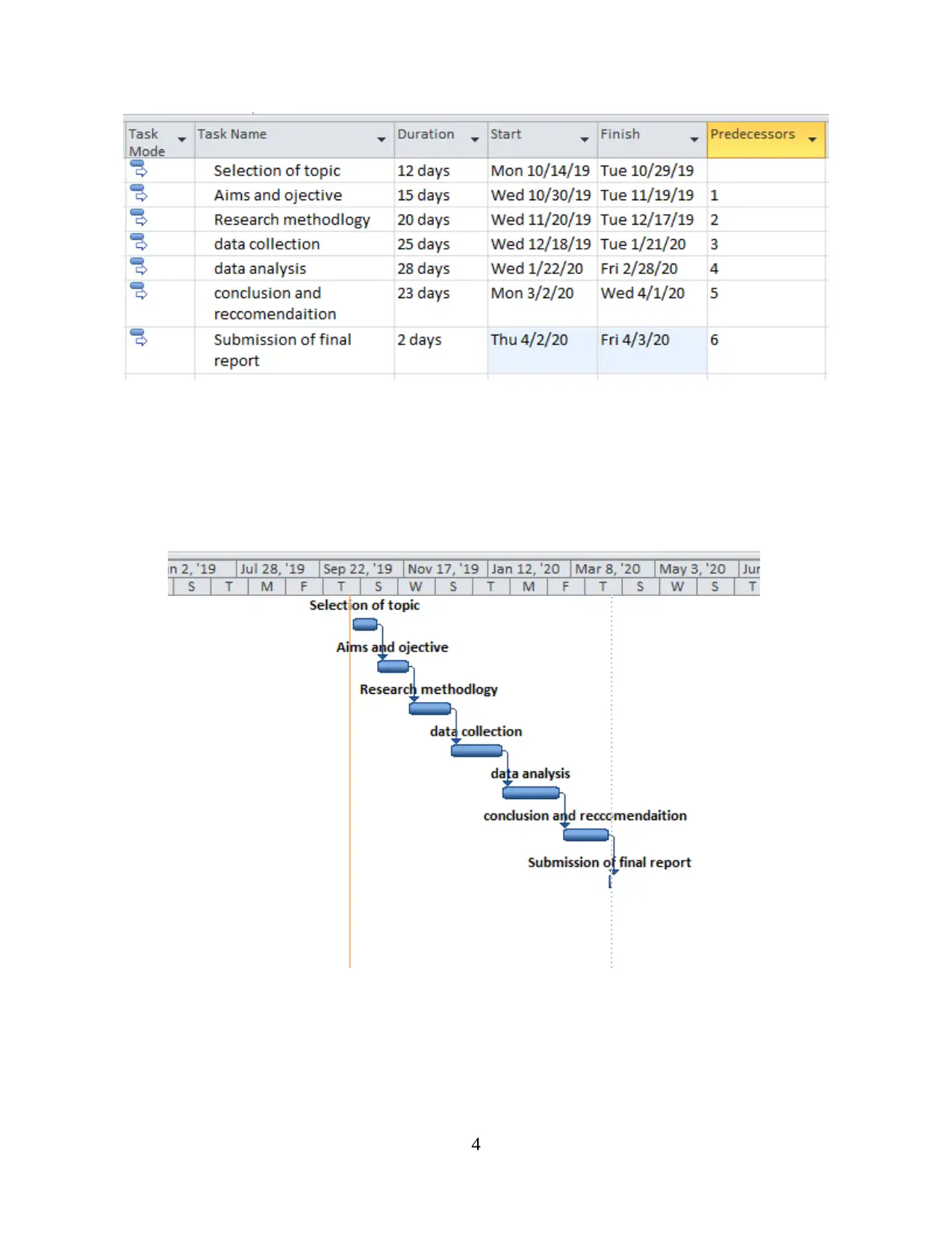
4
⊘ This is a preview!⊘
Do you want full access?
Subscribe today to unlock all pages.

Trusted by 1+ million students worldwide
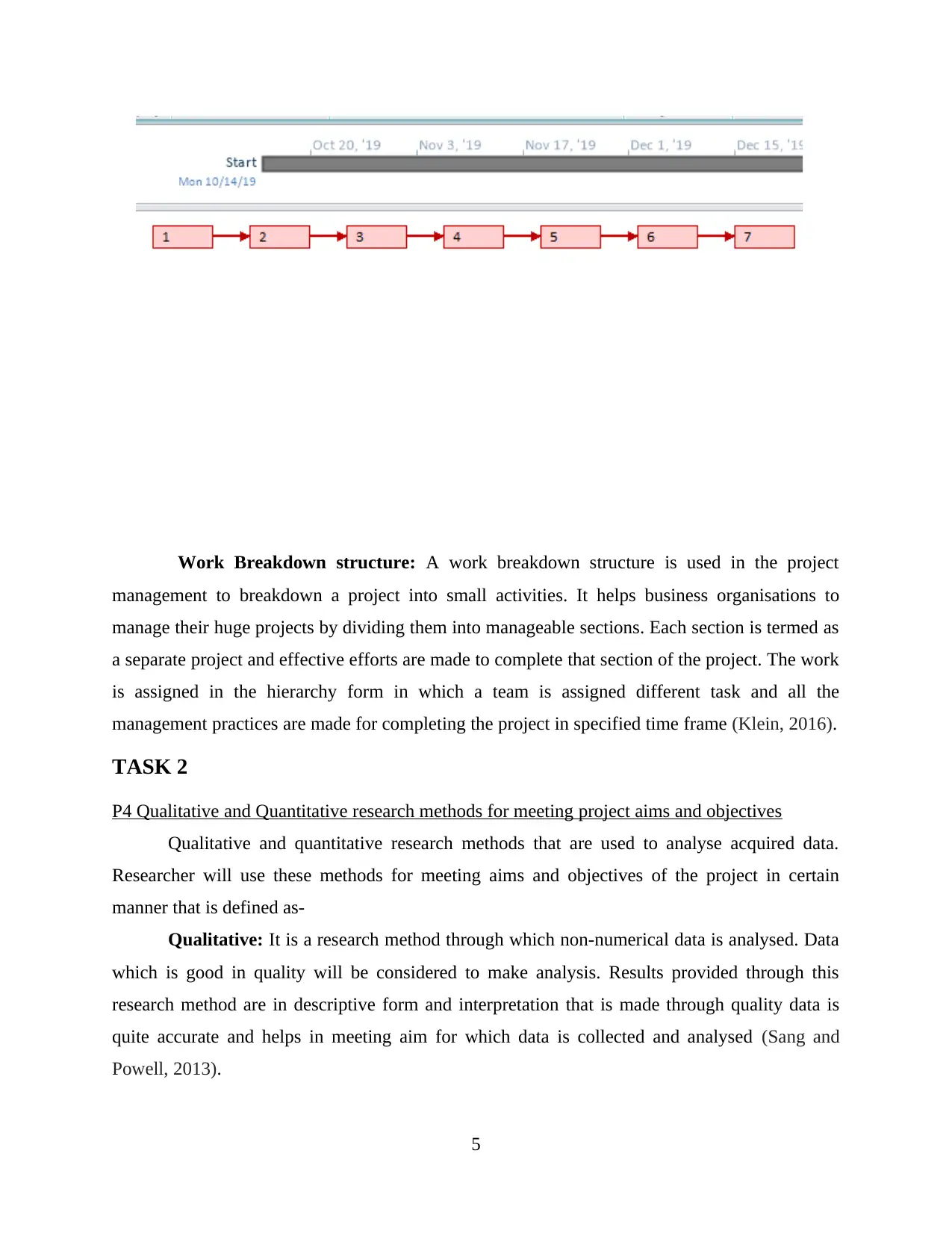
Work Breakdown structure: A work breakdown structure is used in the project
management to breakdown a project into small activities. It helps business organisations to
manage their huge projects by dividing them into manageable sections. Each section is termed as
a separate project and effective efforts are made to complete that section of the project. The work
is assigned in the hierarchy form in which a team is assigned different task and all the
management practices are made for completing the project in specified time frame (Klein, 2016).
TASK 2
P4 Qualitative and Quantitative research methods for meeting project aims and objectives
Qualitative and quantitative research methods that are used to analyse acquired data.
Researcher will use these methods for meeting aims and objectives of the project in certain
manner that is defined as-
Qualitative: It is a research method through which non-numerical data is analysed. Data
which is good in quality will be considered to make analysis. Results provided through this
research method are in descriptive form and interpretation that is made through quality data is
quite accurate and helps in meeting aim for which data is collected and analysed (Sang and
Powell, 2013).
5
management to breakdown a project into small activities. It helps business organisations to
manage their huge projects by dividing them into manageable sections. Each section is termed as
a separate project and effective efforts are made to complete that section of the project. The work
is assigned in the hierarchy form in which a team is assigned different task and all the
management practices are made for completing the project in specified time frame (Klein, 2016).
TASK 2
P4 Qualitative and Quantitative research methods for meeting project aims and objectives
Qualitative and quantitative research methods that are used to analyse acquired data.
Researcher will use these methods for meeting aims and objectives of the project in certain
manner that is defined as-
Qualitative: It is a research method through which non-numerical data is analysed. Data
which is good in quality will be considered to make analysis. Results provided through this
research method are in descriptive form and interpretation that is made through quality data is
quite accurate and helps in meeting aim for which data is collected and analysed (Sang and
Powell, 2013).
5
Paraphrase This Document
Need a fresh take? Get an instant paraphrase of this document with our AI Paraphraser
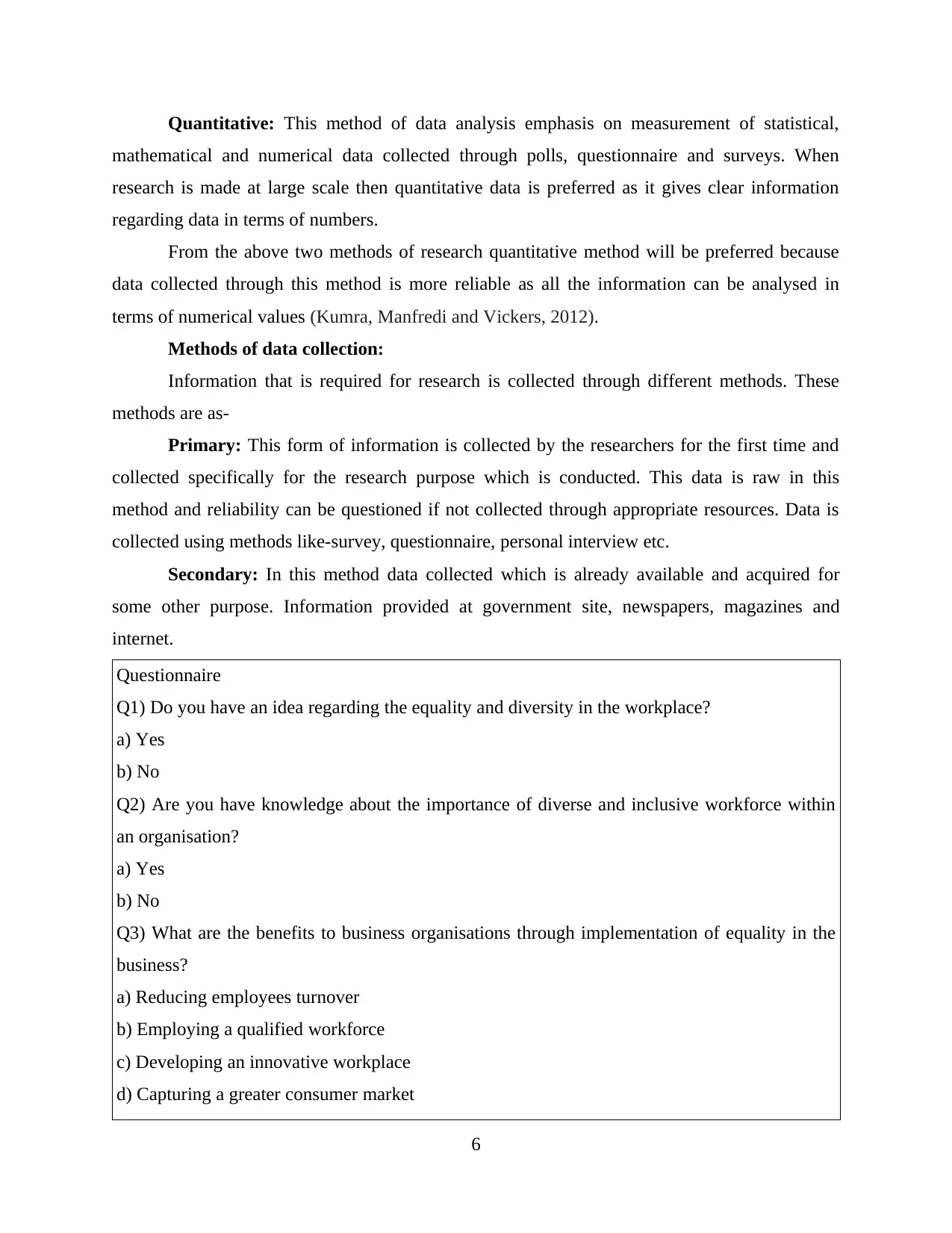
Quantitative: This method of data analysis emphasis on measurement of statistical,
mathematical and numerical data collected through polls, questionnaire and surveys. When
research is made at large scale then quantitative data is preferred as it gives clear information
regarding data in terms of numbers.
From the above two methods of research quantitative method will be preferred because
data collected through this method is more reliable as all the information can be analysed in
terms of numerical values (Kumra, Manfredi and Vickers, 2012).
Methods of data collection:
Information that is required for research is collected through different methods. These
methods are as-
Primary: This form of information is collected by the researchers for the first time and
collected specifically for the research purpose which is conducted. This data is raw in this
method and reliability can be questioned if not collected through appropriate resources. Data is
collected using methods like-survey, questionnaire, personal interview etc.
Secondary: In this method data collected which is already available and acquired for
some other purpose. Information provided at government site, newspapers, magazines and
internet.
Questionnaire
Q1) Do you have an idea regarding the equality and diversity in the workplace?
a) Yes
b) No
Q2) Are you have knowledge about the importance of diverse and inclusive workforce within
an organisation?
a) Yes
b) No
Q3) What are the benefits to business organisations through implementation of equality in the
business?
a) Reducing employees turnover
b) Employing a qualified workforce
c) Developing an innovative workplace
d) Capturing a greater consumer market
6
mathematical and numerical data collected through polls, questionnaire and surveys. When
research is made at large scale then quantitative data is preferred as it gives clear information
regarding data in terms of numbers.
From the above two methods of research quantitative method will be preferred because
data collected through this method is more reliable as all the information can be analysed in
terms of numerical values (Kumra, Manfredi and Vickers, 2012).
Methods of data collection:
Information that is required for research is collected through different methods. These
methods are as-
Primary: This form of information is collected by the researchers for the first time and
collected specifically for the research purpose which is conducted. This data is raw in this
method and reliability can be questioned if not collected through appropriate resources. Data is
collected using methods like-survey, questionnaire, personal interview etc.
Secondary: In this method data collected which is already available and acquired for
some other purpose. Information provided at government site, newspapers, magazines and
internet.
Questionnaire
Q1) Do you have an idea regarding the equality and diversity in the workplace?
a) Yes
b) No
Q2) Are you have knowledge about the importance of diverse and inclusive workforce within
an organisation?
a) Yes
b) No
Q3) What are the benefits to business organisations through implementation of equality in the
business?
a) Reducing employees turnover
b) Employing a qualified workforce
c) Developing an innovative workplace
d) Capturing a greater consumer market
6
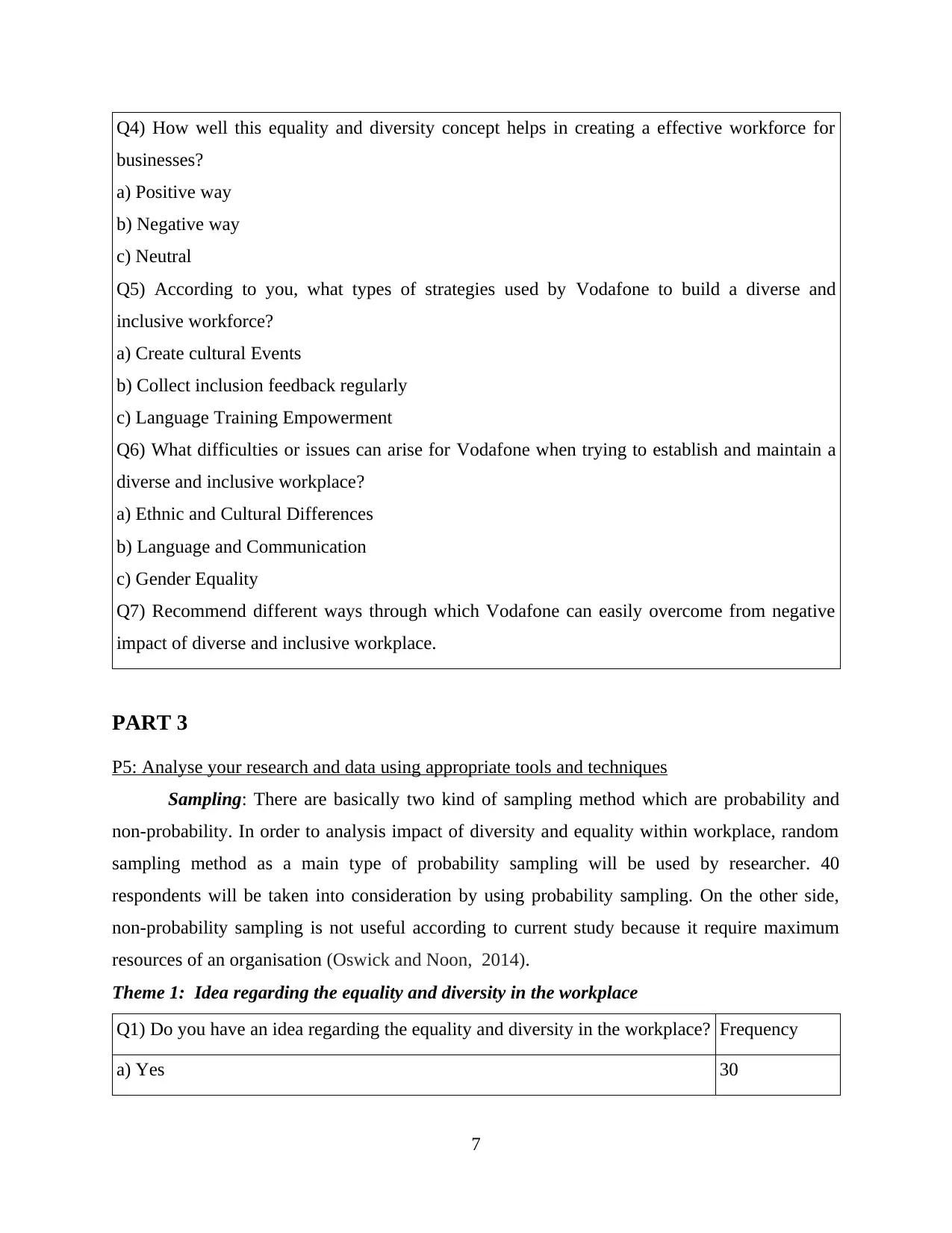
Q4) How well this equality and diversity concept helps in creating a effective workforce for
businesses?
a) Positive way
b) Negative way
c) Neutral
Q5) According to you, what types of strategies used by Vodafone to build a diverse and
inclusive workforce?
a) Create cultural Events
b) Collect inclusion feedback regularly
c) Language Training Empowerment
Q6) What difficulties or issues can arise for Vodafone when trying to establish and maintain a
diverse and inclusive workplace?
a) Ethnic and Cultural Differences
b) Language and Communication
c) Gender Equality
Q7) Recommend different ways through which Vodafone can easily overcome from negative
impact of diverse and inclusive workplace.
PART 3
P5: Analyse your research and data using appropriate tools and techniques
Sampling: There are basically two kind of sampling method which are probability and
non-probability. In order to analysis impact of diversity and equality within workplace, random
sampling method as a main type of probability sampling will be used by researcher. 40
respondents will be taken into consideration by using probability sampling. On the other side,
non-probability sampling is not useful according to current study because it require maximum
resources of an organisation (Oswick and Noon, 2014).
Theme 1: Idea regarding the equality and diversity in the workplace
Q1) Do you have an idea regarding the equality and diversity in the workplace? Frequency
a) Yes 30
7
businesses?
a) Positive way
b) Negative way
c) Neutral
Q5) According to you, what types of strategies used by Vodafone to build a diverse and
inclusive workforce?
a) Create cultural Events
b) Collect inclusion feedback regularly
c) Language Training Empowerment
Q6) What difficulties or issues can arise for Vodafone when trying to establish and maintain a
diverse and inclusive workplace?
a) Ethnic and Cultural Differences
b) Language and Communication
c) Gender Equality
Q7) Recommend different ways through which Vodafone can easily overcome from negative
impact of diverse and inclusive workplace.
PART 3
P5: Analyse your research and data using appropriate tools and techniques
Sampling: There are basically two kind of sampling method which are probability and
non-probability. In order to analysis impact of diversity and equality within workplace, random
sampling method as a main type of probability sampling will be used by researcher. 40
respondents will be taken into consideration by using probability sampling. On the other side,
non-probability sampling is not useful according to current study because it require maximum
resources of an organisation (Oswick and Noon, 2014).
Theme 1: Idea regarding the equality and diversity in the workplace
Q1) Do you have an idea regarding the equality and diversity in the workplace? Frequency
a) Yes 30
7
⊘ This is a preview!⊘
Do you want full access?
Subscribe today to unlock all pages.

Trusted by 1+ million students worldwide
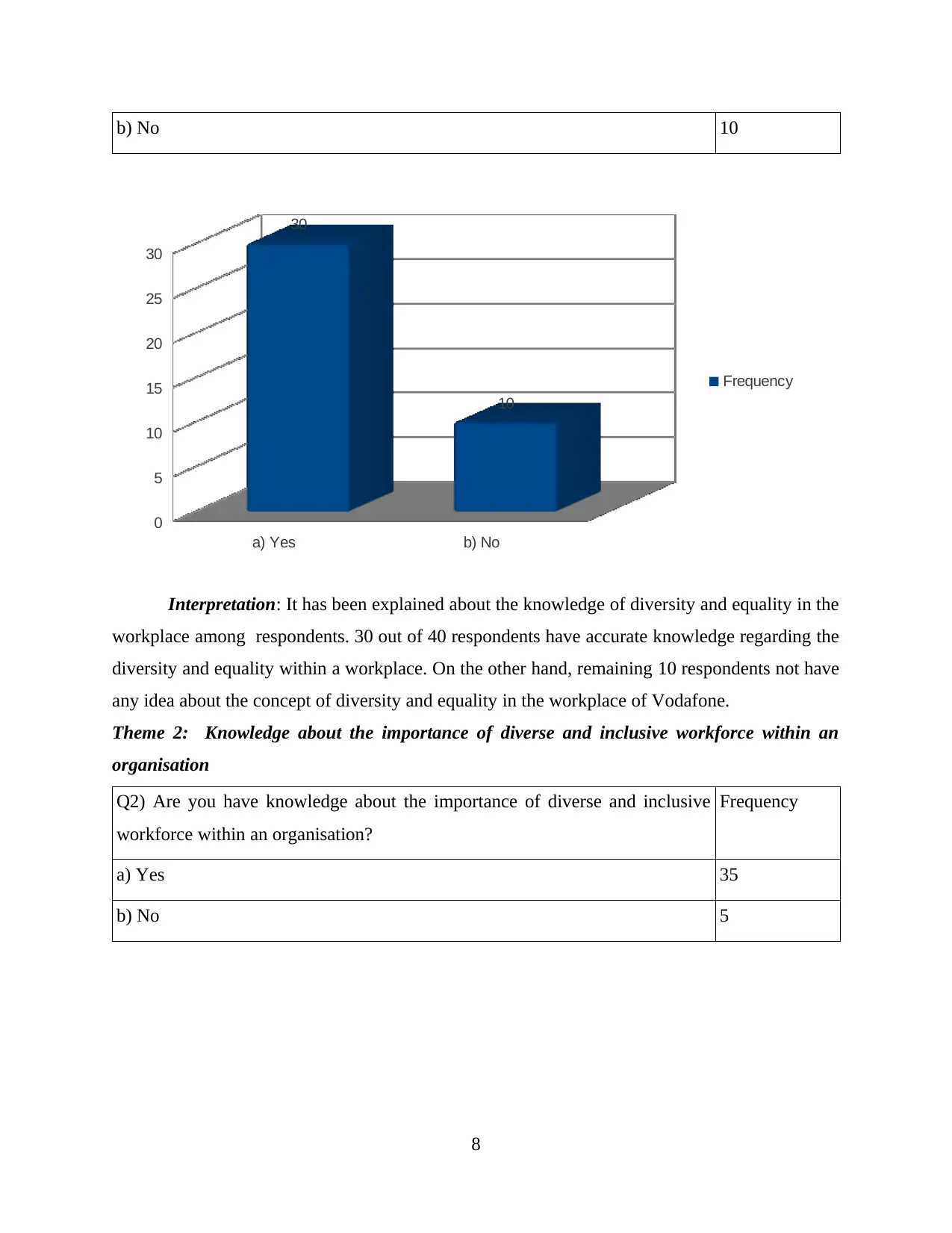
b) No 10
a) Yes b) No
0
5
10
15
20
25
30
30
10
Frequency
Interpretation: It has been explained about the knowledge of diversity and equality in the
workplace among respondents. 30 out of 40 respondents have accurate knowledge regarding the
diversity and equality within a workplace. On the other hand, remaining 10 respondents not have
any idea about the concept of diversity and equality in the workplace of Vodafone.
Theme 2: Knowledge about the importance of diverse and inclusive workforce within an
organisation
Q2) Are you have knowledge about the importance of diverse and inclusive
workforce within an organisation?
Frequency
a) Yes 35
b) No 5
8
a) Yes b) No
0
5
10
15
20
25
30
30
10
Frequency
Interpretation: It has been explained about the knowledge of diversity and equality in the
workplace among respondents. 30 out of 40 respondents have accurate knowledge regarding the
diversity and equality within a workplace. On the other hand, remaining 10 respondents not have
any idea about the concept of diversity and equality in the workplace of Vodafone.
Theme 2: Knowledge about the importance of diverse and inclusive workforce within an
organisation
Q2) Are you have knowledge about the importance of diverse and inclusive
workforce within an organisation?
Frequency
a) Yes 35
b) No 5
8
Paraphrase This Document
Need a fresh take? Get an instant paraphrase of this document with our AI Paraphraser
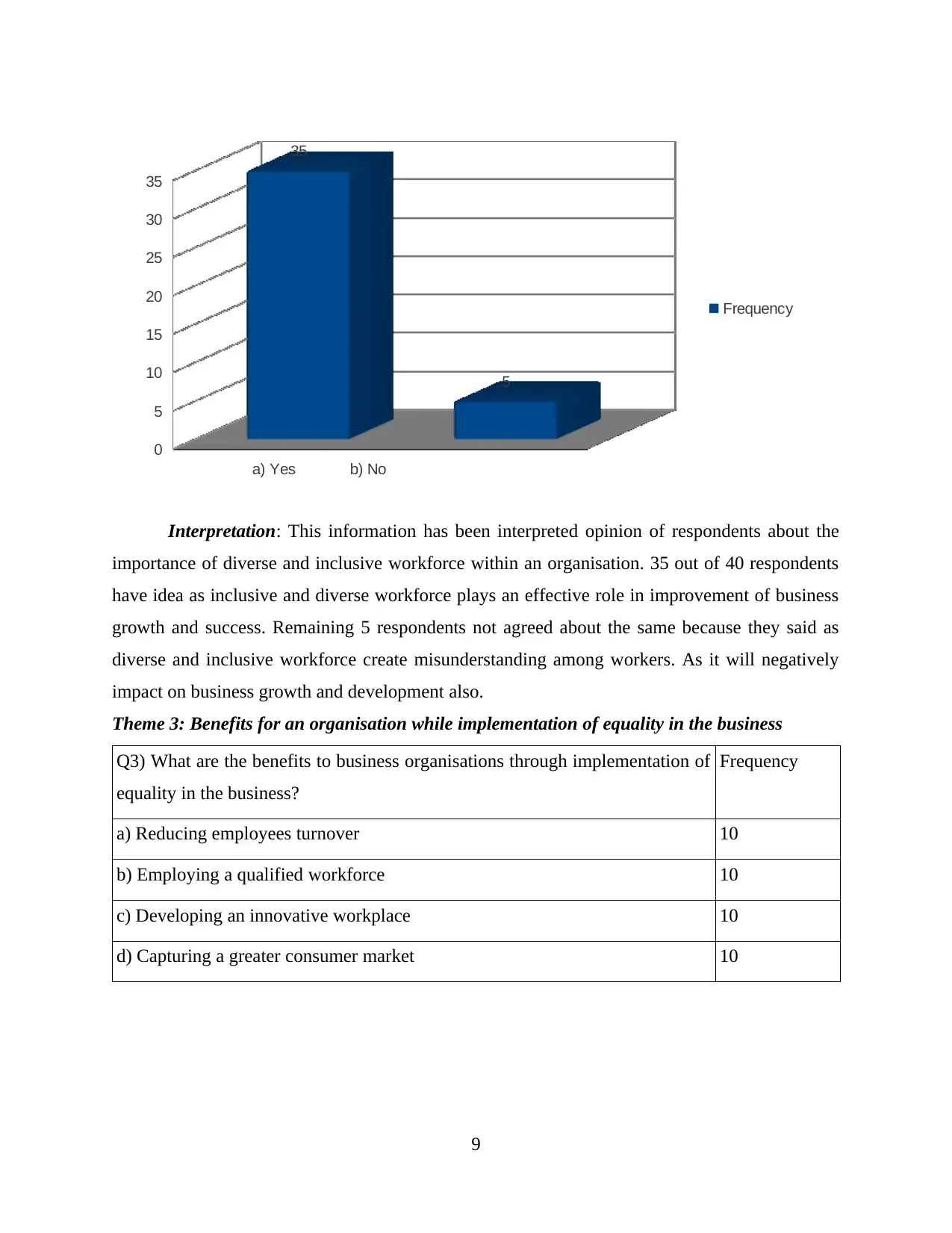
a) Yes b) No
0
5
10
15
20
25
30
35
35
5
Frequency
Interpretation: This information has been interpreted opinion of respondents about the
importance of diverse and inclusive workforce within an organisation. 35 out of 40 respondents
have idea as inclusive and diverse workforce plays an effective role in improvement of business
growth and success. Remaining 5 respondents not agreed about the same because they said as
diverse and inclusive workforce create misunderstanding among workers. As it will negatively
impact on business growth and development also.
Theme 3: Benefits for an organisation while implementation of equality in the business
Q3) What are the benefits to business organisations through implementation of
equality in the business?
Frequency
a) Reducing employees turnover 10
b) Employing a qualified workforce 10
c) Developing an innovative workplace 10
d) Capturing a greater consumer market 10
9
0
5
10
15
20
25
30
35
35
5
Frequency
Interpretation: This information has been interpreted opinion of respondents about the
importance of diverse and inclusive workforce within an organisation. 35 out of 40 respondents
have idea as inclusive and diverse workforce plays an effective role in improvement of business
growth and success. Remaining 5 respondents not agreed about the same because they said as
diverse and inclusive workforce create misunderstanding among workers. As it will negatively
impact on business growth and development also.
Theme 3: Benefits for an organisation while implementation of equality in the business
Q3) What are the benefits to business organisations through implementation of
equality in the business?
Frequency
a) Reducing employees turnover 10
b) Employing a qualified workforce 10
c) Developing an innovative workplace 10
d) Capturing a greater consumer market 10
9
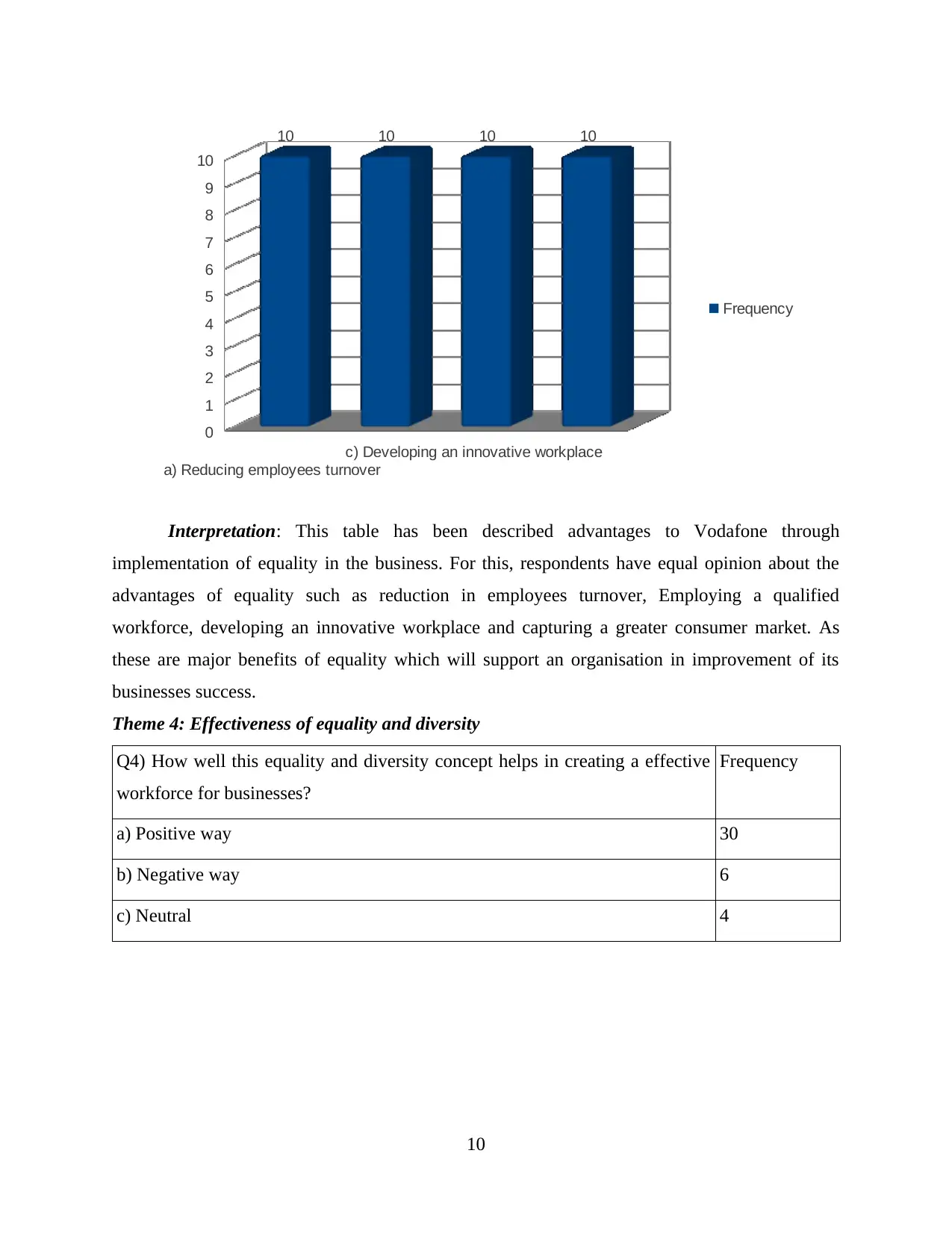
a) Reducing employees turnover
c) Developing an innovative workplace
0
1
2
3
4
5
6
7
8
9
10
10 10 10 10
Frequency
Interpretation: This table has been described advantages to Vodafone through
implementation of equality in the business. For this, respondents have equal opinion about the
advantages of equality such as reduction in employees turnover, Employing a qualified
workforce, developing an innovative workplace and capturing a greater consumer market. As
these are major benefits of equality which will support an organisation in improvement of its
businesses success.
Theme 4: Effectiveness of equality and diversity
Q4) How well this equality and diversity concept helps in creating a effective
workforce for businesses?
Frequency
a) Positive way 30
b) Negative way 6
c) Neutral 4
10
c) Developing an innovative workplace
0
1
2
3
4
5
6
7
8
9
10
10 10 10 10
Frequency
Interpretation: This table has been described advantages to Vodafone through
implementation of equality in the business. For this, respondents have equal opinion about the
advantages of equality such as reduction in employees turnover, Employing a qualified
workforce, developing an innovative workplace and capturing a greater consumer market. As
these are major benefits of equality which will support an organisation in improvement of its
businesses success.
Theme 4: Effectiveness of equality and diversity
Q4) How well this equality and diversity concept helps in creating a effective
workforce for businesses?
Frequency
a) Positive way 30
b) Negative way 6
c) Neutral 4
10
⊘ This is a preview!⊘
Do you want full access?
Subscribe today to unlock all pages.

Trusted by 1+ million students worldwide
1 out of 18
Related Documents
Your All-in-One AI-Powered Toolkit for Academic Success.
+13062052269
info@desklib.com
Available 24*7 on WhatsApp / Email
![[object Object]](/_next/static/media/star-bottom.7253800d.svg)
Unlock your academic potential
Copyright © 2020–2025 A2Z Services. All Rights Reserved. Developed and managed by ZUCOL.





